
Laying down the chips
By George Guidoni, Editor
General decentralization Frito-Lay Canada Marc Guay PepsiCo PepsiCo Foods Canada Quaker snack foodsIt is surprising how relatively few Canadian-based companies manage to pull it off on a daily basis with the level of skill, aplomb and reward that has enabled PepsiCo Foods Canada to become the country’s runaway leader in the fiercely competitive snack-food market in last decade under the thoughtful and energetic leadership of president Marc Guay.
Thinking globally while acting locally is not a radically new notion in 21st Century manufacturing. But it is surprising how relatively few Canadian-based companies manage to pull it off on a daily basis with the level of skill, aplomb and reward that has enabled PepsiCo Foods Canada to become the country’s runaway leader in the fiercely competitive snack-food market in last decade under the thoughtful and energetic leadership of president Marc Guay.
“I joined PepsiCo because I saw an organization that was global, but liked to operate its businesses locally—having the resources of a very big company, but also empowering every global market where it operates to make decisions that are right for their local business,” says the youthful-looking, 52-year-old Montreal native who joined the Mississauga, Ont.-headquartered Canadian subsidiary of global food-and-beverage giant PepsiCo 25 years ago.
Having just reached his 10th anniversary as president of a multibillion-dollar enterprise employing more than 5,500 Canadians at eight manufacturing operations across the country—including the Frito Lay Canada snack-food plants and the Quaker cereals, bars and snacks business—Guay credits the Purchase, N.Y.-headquartered parent company’s long-maintained tradition of entrusting its global subsidiaries with sufficient autonomy and decision-making authority to nurture genuine product innovation for its stellar growth in Canada.
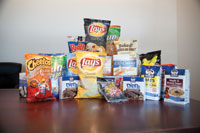
A random sampling of a multitude of bestselling snack and cereal brands produced in Canada by PepsiCo’s Frito Lay and Quaker operations, including the busy, 375,000-square-foot facility in Cambridge, Ont., which produces more than 110 million pounds of potato chips and other popular snack products, accounting for about 45 per cent of all the Frito Lay chip production in Canada.
“There were not a lot of global companies that operated this way 25 years ago, and I guarantee you that there are even fewer companies operating like that today,” Guay told Canadian Packaging in a recent interview at the PepsiFoods Canada headquarters in Mississauga, about a half-hour drive northwest of Toronto.
One of a Kind
“I suspect we may be one of the last top 20 food companies in Canada today to operate in such a decentralized way as we do,” says Guay, whose first post-university work experience took him to Switzerland for a year to learn the ropes of a family business operated by his parents.
“While I really enjoyed living in Switzerland and learning about the family business, the one big thing I learned really well was that I did not want to be in a family business,” he chuckles. “So I came back to Canada, began working in sales for Procter & Gamble, and after five years there I got an opportunity to come and work at Frito Lay.”
Says Guay: “Because we are so decentralized, Canada has been a source of great innovation for PepsiCo and for other PepsiCo countries, about 150 of them, around the world.
“There are brands that we have created here, in fact entire product categories, which now exist in dozens of other countries, including the U.S., and I dare say that Canada has been perhaps the number one source of innovation for PepsiCo around the world—not only in terms of brands, but also the innovation in terms of the ingredients we use, our production process, and so forth.”
Guay cites the remarkably fast growth of the company’s Munchies brand of mixed snacks as one of many inspiring examples of Canadian innovative savoir faire helping the company reap enormous global marketplace gains.
“We wanted to get into snack-mix business back in late 1990s,” Guay recalls. “We let our employees pick out the brand name, which was already a mascot name for our for Hostess brand of chips, pick out a whole bunch of different snacks, put them into bowls in a kitchen, try the different mixes, rate them … and 15 years later we have a billion-dollar global business.
“The Munchies product line is a truly made-in-Canada brand that has been adopted by that name in many other countries, including in the U.S., where they just rebranded their entire line of single-serve crackers from Frito Lay to Munchies crackers,” relates Guay, adding that the rebranding earned Frito Lay a Best Innovation of 2010 award of the National Association of Convenience Stores in the U.S.
“It’s all about entrepreneurship, which goes back to that notion of being a decentralized operation that creates a culture of entrepreneurship where people feel empowered to come up with new ideas and new ways of doing things,” states Guay.
The value of such autonomy was fully displayed last fall when PepsiCo’s popular SunChips brand found itself in a maelstrom of online consumer criticism in the U.S. on the account of allegedly excessive noise emitted by the recently-launched compostable PLA (polylactic acid) bags made from renewable plastic resins—derived from corn starch—produced by leading bioplastics manufacturer NatureWorks LLC.
Stung by the viral nature of the “anti-noise” online campaign carried out via YouTube clips and Twitter messaging, PepsiCo responded by quickly switching five of the six SunChips flavors sold in the U.S. back to the original noncompostable bags, while promising to work on developing a new range of quieter PLA bags.
While the new bags are now all set to debut in both the U.S. and Canada later this year, Guay points out that the Canadian Frito Lay business not only decided to stick it out with the original PLA bags, but also bought ad space in daily newspapers and posted its own video clips on YouTube to point out the bags’ many environmental virtues, while playfully offering free earplugs to all Canadian consumers requesting them.
“Our plan was always to stay the course in Canada because we know that Canadians are much more receptive to environmental initiatives like this one,” Guay remarks.
“It’s not that they are not committed to sustainability in the U.S., where they also got some positive feedback as well, but the fact is that the composting rate for the U.S. households is about three per cent, whereas it is close to 30 per cent in Canada,” Guay points out. “We had over 8,000 new ‘friends’ signing up on our Facebook page within a few days of creating it—telling us to keep the compostable bags here in Canada.”
Adds PepsiCo Food Canada’s director sustainability and productivity Helmi Ansari: “The original compostable package was a huge innovation—it was the first PLA package that you could metallize but still maintain all the compostability specifications so that it breaks down in an acceptable period of time.
“This new bag is another huge step forward in that technology right to the next level—making it a much softer and quieter material at room temperatures,” Ansari says, revealing that initial work on the quieter PLA bags, conducted jointly with the company’s exclusive flexible packaging supplier Bryce Packaging, Inc., commenced more than two years ago.
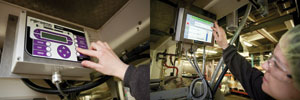
A Videojet thermal coder (right) and a Vertex metal detection system from Fortress Technology (left) are employed above every Ishida form-fill-seal bagging machine located throughout the busy Cambridge facility’s packaging lines to ensure optimal produce safety, quality and traceability.
Quiet Time
“In terms of noise, the new package is very comparable to the standard polypropylene bags even though its is made from PLA, which is normally a much crisper material at regular room temperatures,” says Ansari, noting that the new PLA bags emit at least half less noise compared to their predecessors, while also maintaining their crisp shape much better on the store-shelves even after repeated handling.
“I don’t know of any other package in the history of consumer packaged goods in Canada that has generated so much public attention and so many strong feelings,” Guay reflects. “In the end there was a lot more positive consumer feedback in Canada than negative, which is why we kept the compostable bag across the whole SunChips portfolio.”
That said, Guay fully respects how PepsiCo went about its bag switch in the U.S., commending the ability of different global PepsiCo businesses to respond to their respective market challenges flexibly as they see fit.
Says Guay: “The bulk of people don’t buy our snacks because of anything other than that they taste great and they are affordable: that’s the number one reason why people buy our products.
“Even if we had zero waste and used no water or energy, if our products did not taste good, I’m not sure most consumers would necessarily buy our stuff just on those basis alone,” he reasons. “Maybe some would, but at the end of the day it’s all about quality and affordability of our products.”
This relentless focus on product quality and pricing has paid off handsomely for the Frito Lay business over the last 10 years, Guay reveals.
“When I joined the company, Frito Lay was number four in the Canadian salty snacks market,” he recalls. “It is now taken for granted that we’re the number one player but that wasn’t always the case. But these days about two of every three dollars spent in Canada on snacks is spent on Frito Lay snacks.”
According to Guay, the company’s approach to packaging and customer service has played a major role in Frito Lay’s growth in the last decade.
“For one, we make most of what we sell in this country, whereas a lot of other companies import from the U.S.,” he states. “We have always believed, going way back, that being close to our markets has significant benefits, so operating eight plants in Canada, on the food side alone, really helps drive the employment here.
“The other reason we employ more people than other food companies,” he explains, “is due to the fact that we go to market using direct-to-store delivery, which means maintaining a large sales force that actually delivers products to the stores daily and merchandises them for the customer.
“There are about 2,000 salespeople who work on the food side of PepsiCo’s Canadian business, and that’s a lot more than any other food company in this country,” points out Guay.
“Our people will actually take the bags and the boxes out of the shipping case and put them on the shelves for our retail customers, build the POP (point-of-purchase) displays in the store and so on,” he expands. “There’s also the issue of freshness. We have a limited shelf-life for our products, so it’s really important to us that they are well-rotated and, in the odd case that a product expires on the shelf, that we pull it off as quickly as we can.
“We like to do that work for the retailers so that they don’t have to worry about our products,” Guay states, adding that having similar control over the company’s packaging strategies and development is also crucial to its ongoing success in the marketplace.
“All our graphic design work is done locally, because not only do we want to maintain control of the identity of the brand in Canada, we also need to maintain the alignment with what the brands look like at the rest of PepsiCo’s markets,” Guay relates. “It’s no coincidence that a bag of Lays chips you’ll find in Canada will look familiar with what you’ll see in Japan or elsewhere in Asia.
“Snack-food product categories are highly-impulsive: over half of all purchase decision are made at the store—making our packaging our last point of contact with the consumer before they buy the product,” says Guay. “So it’s very important that the package looks good and attractive, and that it communicates the information of the brand, the flavor, the size and so on, in a very clear way to the consumers.
“Packaging has always been a very important marketing vehicle, and it is becoming even more important as efforts to build brands are becoming ever more complex, due to the influence of traditional media declining in our collective lives,” he expands.
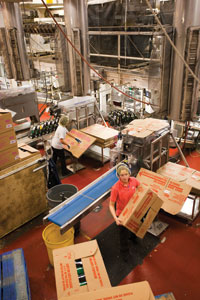
An overview of secondary packaging operations at the busy Frito Lay manufacturing facility in Cambridge, which employs over 600 people on a 24/7 schedule to turn out hundreds of SKUs (stock-keeping units) of some of the company’s perennial bestselling brands. Packaging machine operator Bruce Haines makes on-the-fly adjustments to the fully-automatic Douglas Machine case-packing line that utilizes high-performance suction cups to ensure gentle placement of bags of potato chips into the corrugated shipping boxes.
“People definitely watch far fewer TV commercials today than they did 10 years ago, for example, and it’s becoming much more difficult to reach the consumer in other traditional ways, so the importance of good packaging will continues to grow in terms of package design and how well it communicates with the consumers.”
According to Guay and Ansari, having full control of its packaging enables Frito Lay to pursue a proactive approach to packaging sustainability, whereby a lot of its secondary packaging get reused many times after the initial delivery to retailers—most notably the corrugated shipping carriers supplied to Frito Lay by the Toronto-based Atlantic Packaging Products Limited.
“Each one of our shipping cartons get reused five or six times on average,” points out Ansari. “We did some rough math on this, and over the last three years alone, we estimate we have saved over two million trees by reusing these boxes multiple times before ultimately recycling them, rather than using them once and sending them to recycling.”
Adds Guay: “Again, this is possible because of our direct-to-store delivery system, whereby our people are in the stores everyday and they can collect these boxes for reuse.
“We simply couldn’t do it without having all those salespeople out there, we’d become just like any other company that sends its cardboard boxes to the retailers’ warehouses and thus lose control and sight of our cases,” he elaborates.
Second Life
“We’ve been using reusable cartons for as long as I remember,” Ansari concurs. “There is probably more secondary packaging used for our products than primary packaging.
“When people think about a bag of chips they only relate it to the primary package itself, but the fact is there is far more material used in the secondary packaging, which also has the highest amount of recycled and recyclable content that we can get in there,” he asserts.
“As for the primary packaging, we always work to make the material as lightweight and thin as possible, but still maintain the freshness of the product and the crisp appearance that you want the package to have on the shelf.”
Despite being a past recipient of some of the most prestigious awards to be handed out for environmental excellence in Canada—including the Environmental Sustainability Excellence Award of the Canadian Council of the Ministers of the Environment; the Energy Conservation Award of Natural Resources Canada; the Green Supply Chain Award of Transport Canada; and a long list of others—PepsiCo Foods Canada takes a surprisingly low-key approach to publicizing its environmental accomplishments.

Packaging machine operator Bruce Haines makes on-the-fly adjustments to the fully-automatic Douglas Machine case-packing line that utilizes high-performance suction cups to ensure gentle placement of bags of potato chips into the corrugated shipping boxes.
States Ansari: “While we are proud and happy to get this recognition, that is not our objective.
“Sustainability and all the other work we do around here is all part of our culture of operational excellence—we do it because we think it’s the right thing to do, and we always have,” he asserts.
“It’s not something we do so we can go and brag to people and to the market about our environmental practices—this is just our operational culture,” says Ansari, who has spent 14 years with PepsiCo, including a stint as manufacturing (plant) manager at the Cambridge, Ont., plant.
While he nowadays spends about half of his time at the Mississauga headquarters, Ansari remains a frequent and popular visitor to the busy, 375,000-square foot production facility operating on an around-the-clock, 24/7 production schedule to turn out over 110 million pounds of potato chips and other snack products per year, including bestselling global brands such as Cheese Puffs, Sun Chips, Lays, Ruffles, Miss Vickies, Tostitos and Doritos, among others.
Employing 615 people, the Cambridge plant accounts for about 45 per cent of the entire Canadian production of Frito Lay snacks, relates Ansari, whose first-name-basis familiarity with the plant’s dedicated and highly-motivated workforce helps facilitate an ongoing exchange of helpful ideas and suggestions on how to continue reducing the plant’s environmental footprint.
“The culture at PepsiCo and Frito Lay has always been completely team-driven: our frontline employees run and drive our day-to-day business,” Ansari states.
“Every one of our employees at the Cambridge plant is on a team—be it a packaging team, a production team, a quality team or a maintenance team,” says Ansari, crediting the plant’s Green Teams for many improvements in packaging sustainability and waste reduction, including a recent introduction of the compostable OXO-Biodegradable brand of stretchwrap film—supplied by Canpaco Inc. of Concord, Ont.—to the plant’s end-of-line packaging operations.
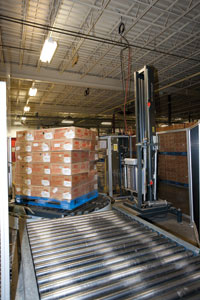
A fully-automatic Wulftec turnable stretchwrapping system applies layers of OXO-Biodegradable stretchwrap film, developed by Intertape and distributed by Canpaco, onto a palletized load of product.
“We also have Resource Conservation teams, driven by frontline employees, whose role is to reduce energy consumption, water use and waste associated with the plant’s food production,” Ansari elaborates, “as well as Zero Landfill teams who specifically focus on reducing our landfill waste.
“As a result of all this teamwork to innovate our processing and packaging processes, over 95 per cent of the waste produced in our facilities across Canada never goes to a landfill, but is instead diverted for some possible reuse,” Ansari confides.
“For example, the leftover starch produced when we slice the potato chips is now converted into dry starch instead of being thrown out as waste, which can be used as a processing ingredient in other industries.
“We had our Green Teams in place back in the 1990s—long before it became a cool thing to do,” says Ansari, noting the that plant now uses 40 per cent less water to produce a bag of chips than it did in 1999, as well as 20 per cent less natural gas and 20 per cent less electricity.
“We are now targeting to reduce our water use by 75 per cent [compared to 1999] and our energy intake for natural gas by 50 per cent, and although this is something we jokingly refer to us BHAGs— Big Hairy Audacious Goals—we think we’ll get there soon by continuing down the path to a corporate vision that we call ‘Leave no Trace.’
“We aspire to a vision that one day all manufacturing, ours and others’, will operate with no environmental footprint at all,” says Ansari. “We know that this is a very challenging and bold vision, and a very long-term vision, but we have already taken some important steps to getting there.”
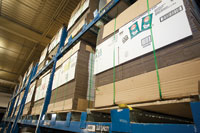
Strapped stacks of palletized pre-printed corrugated boxes, manufactured by Mitchel-Lincoln Packaging, are stored on steel racking in the Cambridge plant’s vast warehousing area near the shipping docks.
Given the highly competitive nature of the snack-food business, especially with the strong growth of lower-priced private-label competition during the recent recession, the Cambridge facility is continually challenged to retain its competitive edge by operating as a truly lean manufacturing enterprise, says Ansari, noting that despite being the largest Frito Lay plant in Canada, it only ranks as a “mid-sized operation” among the 37 Frito Lay manufacturing plants operating across North America.
“Using a balanced ‘scorecarding’ process, we measure and act on performance metrics on an hourly basis,” Ansari relates. “Our highly engaged teams and team members review performance at every packaging line hour-by-hour, and get together multiple times each shift to action-plan and work on their key metrics such as safety, package quality, packaging machine operating efficiency, packaging material usage efficiency, schedule attainment, ingredient conversion efficiencies, total labor utilization efficiencies, energy efficiencies and waste reduction.
“Those metrics are very detailed and there are various sets of scorecards that are maintained and acted on by various teams across the facility to achieve the high targets we set for ourselves.”
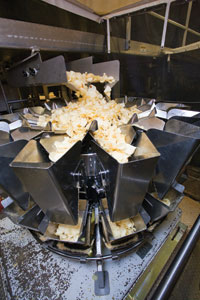
Positioned just above the Cambridge plant’s packaging lines, a multibucket scale dispenses precisely-measured quantities of freshly-made potato chips down to the Ishida form-fill-seal baggers below.
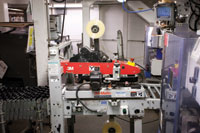
One of several 3M-Matic case-sealing machines from the 3M Company used to secure bags of potato chips inside the corrugated shipping cases.
Ansari explains that the continuous improvement process employed at Frito Lay’s Cambridge and other Canadian facilities is rooted in rigorous implementation of the Lean Six Sigma quality management methodology for quality management and assurance, as well as strict adherence to the highest possible sanitary and hygienic standards in all parts of each and every facility.
“We utilize Lean Six Sigma as a key tool to drive improvements across all parts of our business operations, using a group of internal Lean Six Sigma black belts, green belts and many Kaizen leaders for continually driving projects and initiatives to deliver broad spectrum improvements in safety, quality, productivity, sustainability and service,” Ansari relates.
“Given our market leadership and scale advantages,” he sums up, “we have developed one of the most stringent and effective quality systems for our products in the world.
“These are tightly monitored processes that are built on ISO principles, and are audited internally and externally at every facility on a regular basis.”
Photos by Sandra Strangemore
Advertisement

